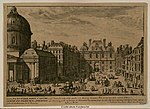Maxim's Art Nouveau Collection 1900

Maxim's Art Nouveau "Collection 1900", also known as the Musée Art Nouveau - Maxim's, is a private collection of Art Nouveau objects and decor, located in the 8th arrondissement above Maxim's Paris restaurant at 3, Rue Royale, Paris, France. It is open for guided tours in afternoons except Monday and Tuesday; an admission fee is charged. Pierre Cardin (the owner since 1981 of Maxim's restaurant, a symbol for Art Nouveau) has collected for over 60 years objects from the Belle Epoque. There are more than 550 pieces from all over the world, signed by Louis Majorelle, Louis Comfort Tiffany, Émile Gallé, Henri de Toulouse-Lautrec and Clement Massier. These objects are displayed in a 12-room apartment building (three floors) which is now classified as a historic monument. Highlights of the collection include furniture by Majorelle, a sofa inspired by Antoni Gaudí and recreations of bedrooms from that time period.
Excerpt from the Wikipedia article Maxim's Art Nouveau Collection 1900 (License: CC BY-SA 3.0, Authors, Images).Maxim's Art Nouveau Collection 1900
Rue Royale, Paris 8th Arrondissement of Paris (Paris)
Geographical coordinates (GPS) Address Nearby Places Show on map
Geographical coordinates (GPS)
| Latitude | Longitude |
|---|---|
| N 48.8675 ° | E 2.3222 ° |
Address
Maxim's
Rue Royale 5
75008 Paris, 8th Arrondissement of Paris (Paris)
Ile-de-France, France
Open on Google Maps







